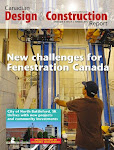 The Tower of Terror is probably the most popular ride at Disney's California Adventure. It is a wild "elevator" ride in the Hollywood Hotel -- at one point, the doors open and park visitors can hear the screaming riders from high up.
The Tower of Terror is probably the most popular ride at Disney's California Adventure. It is a wild "elevator" ride in the Hollywood Hotel -- at one point, the doors open and park visitors can hear the screaming riders from high up.If you play the video from the previous California Screamin' posting, you'll see images of one rather wild roller-coaster ride. The idea of this type of entertainment is to give you a thrill: Doing something scary that you know is safe -- even for your kids. And from a marketing perspective, that is the magic of branding, or more accurately, the branding experience. It also is a key element of success in marketing construction services.
To explain: On Friday, as I considered whether to risk riding what seemed to be the scariest rides imaginable (like a really fast roller-coaster with a 180 degree loop), I thought: "Has there ever been a fatality at a Disney site when a ride failed?" My reaction as I boarded the ride -- "This stuff is so safe that there is no real risk."
It turns out there have actually been some accidents and crashes (mostly fortunately minor in nature) over the years at Disney park attractions. You can find out additional details at Rideaccidents.com. But I didn't know this when I was there; I sense most Disney patrons have similar perceptions. In any case, most people consider the rides safe enough for the risk (certainly thousands of people fly or drive to Disney sites each year, and I expect there are enough plane and car accidents along the way to top the Disney accident frequency.)
Consider other elements of the Disney experience: You don't find the low-lifes that hang around many amusement parks and carnivals; all employees of course are briefed and trained (and I'm sure screened) for client suitability; the fun is tightly scripted and controlled, and once you've had the experience, you know what to expect.
There are changes every year, but the basic rules remain the same. You pay a flat rate to enter the park for the day, ride as much as you like (but usually get only one shot at the really good rides unless you are willing to endure a truly major wait), and you can spend as much as you like on extras including food and souvenirs (but Disney does not impose the irritating restrictions on your bringing your own food on site to save costs.) In other words, the experience, while not inexpensive, leaves you feeling you've been treated fairly.
Of course, Disney has turned it experience into corporate programs for training and motivation at the Disney Institute. I'm not sure if these services are worthwhile to most construction businesses, but you can see here how they are able to leverage their brand in new and interesting ways.
Fair enough. But what do amusement parks have to do with construction businesses? The answer is in your ability to overcome the fears of your current and potential clients of the bad experiences they either have heard or experienced in the past. If you are an architect or engineer, are you dealing with people who have had bad luck with sloppy design, missed schedule, or less-than-perfect trade relationships? If you are a general or sub-contractor, have you met people who have been burned by incomplete jobs, messy sites, and offensive employees? And if you are a residential contractor, do your clients have experience (or fear) of work not completed right, on schedule, and with massive inconvenience to their lives?
If your work shares any of these less-than-wonderful qualities, your brand is mud. You can spend a fortune on advertising and marketing, and end up with very little: Sure, a few new clients (or suckers) might arrive through expensive promotion, but your marketing cost will magnify because you will lose many potential clients as bad word-of-mouth spreads faster than your marketing can overcome.
Conversely, if your work is good enough to attract unsolicited repeat and referral business (to the point, in good times, you didn't need to advertise because you relied on repeat and referral business), you have an excellent brand. You now need to leverage and develop it through marketing, both to current and potential clients and new customers.
Here, advertising really will work for you and if you are truly successful, you will budget in the range of five per cent and 10 per cent of your sales volume for advertising (and additional funds, if you wish to use a direct sales force). Simply ensure your pricing is able to sustain this marketing cost -- but don't worry, businesses with solid brands (that is great reputations) can charge more for the same services as their competitors.
Consider Disney. They don't offer many coupons, discounts, special savings or the like -- especially for short-term visitors. Disney has built a brand based on safe, fun, family entertainment. The story may be partly mythology -- as I strapped myself into the roller coaster seat, I (falsely) thought no one had actually been injured on a Disney roller coaster. But I had been sold by the brand, and felt secure that when the ride ended I would be safe, and would want more of the same.
Your objective in developing your construction industry marketing is to achieve the same goal: A brand that attracts repeat and referral business, because clients perceive your service is really safe, fair, and enjoyable.









No comments:
Post a Comment